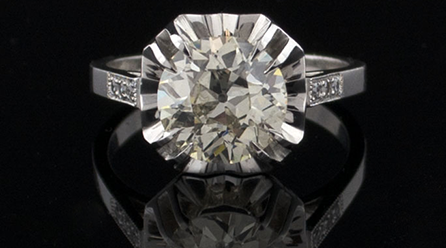Why is My Diamond Worth Less Than I Thought It Was?
We have been purchasing diamonds for over 44 years and have helped countless consumers better understand the diamond market and achieve the best possible offer for their diamonds and jewelry. People are often surprised when they hear that their diamond is worth less than they paid for it. This example usually gives a better perspective in this situation:
Have you heard that as soon as you drive a new car off the car lot, it loses several thousand dollars in value? Part of the reasoning behind that is dealer markup. No dealer is going to pay you full price for a car that he can buy brand new from the factory for 10% less than you just paid for it. The real value of the car is the dealer cost. Unless you do your research and learn what dealer cost are and how to negotiate a fair price based upon wholesale values, you could end up paying full retail price. The same can be applied when you are buying or selling a diamond.
Unfortunately, there are no guidelines or restrictions to what diamonds can cost so many of the major national jewelry chains take advantage of consumer ignorance and sell consumer grade diamonds for a tremendous mark up that is far above any possible resale value. When we look to buy diamonds from consumers, we always look for high quality, high value diamonds that will retain their value and appreciate over time. We have often had to disappoint eager sellers with the sad truth that their stones are not worth anywhere near what they paid for them a few years ago, even in spite of inflation. This is the reason why its important to buy diamonds that have certified appraisals done by respected and well known gemologists, or buy stones that are independently appraised by a recognized agency like the Gemological Institute of America.
Diamonds appraised by the Institute carry the G.I.A. certification papers. There is a difference between a laboratory report and a jeweler’s appraisal. Lab reports done by an outside agency like the G.I.A. are done by graduate gemologists and are independent from the sales department of any store. Jewelers’ appraisals may be based upon inaccurate information due to the fact that they may not be fully trained gemologists, even though they have many years of experience in the jewelry field. Also, jewelry store appraisals may be based upon the markup of what you paid at retail. The more the store’s profit on the item, the more the appraisal value may be exaggerated. At Joden, we have graduate gemologists, trained by the G.I.A, on staff.
To help you understand how the value of your diamond is determined, many things are taken into consideration. There is a difference between consumer grade diamonds and high quality, high value diamonds. The size of the diamond isn’t the only factor that comes into play when placing a value on a diamond. Many people think that a larger diamond is a better one but it just isn’t true. There are four factors in to grading a diamond and determining its value. Often called the “4 C’s.”, they are Carat (weight/size), Color, Clarity, and Cut. A larger diamond with internal flaws, that is less reflective, and isn’t as clear as a smaller diamond may actually be less valuable. A flawless, perfectly cut, clear diamond, even though smaller, may be worth thousands of dollars up to tens of thousands more.
The bottom line is that if you don’t know the grade of your diamond, based upon the 4 C’s, you don’t know what you are buying. That ends up being the reason many people are disappointed whenever they try to sell their diamond. Most consumer grade diamonds have very little resale value and if the dealer has integrity and wants to deal fairly with his customers, he won’t be interested in them. Becoming an educated consumer means you will avoid the pitfalls of buying an over priced diamond.

